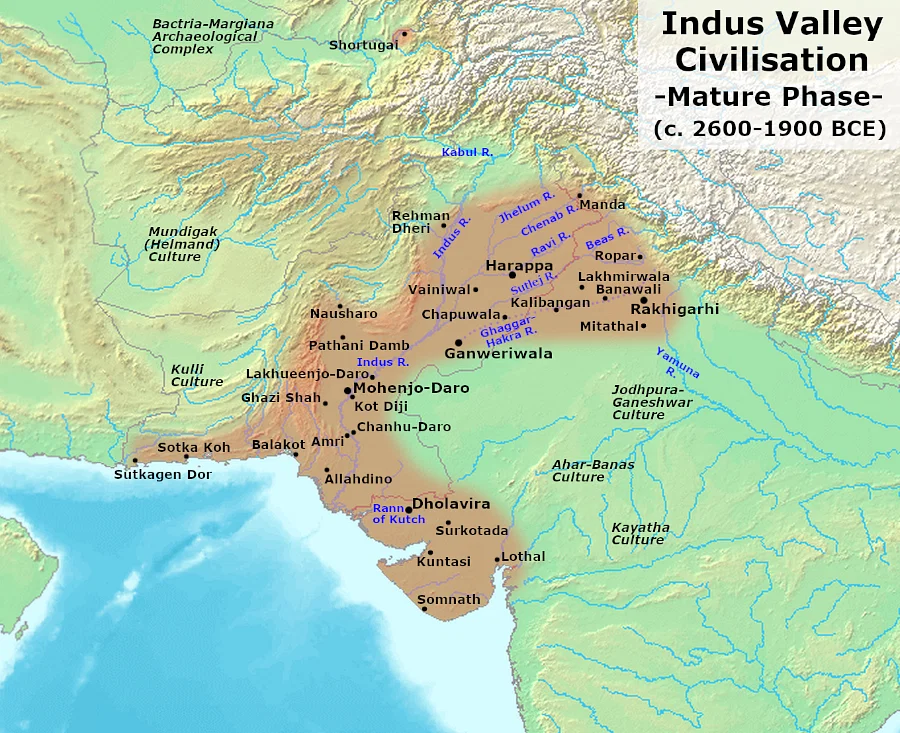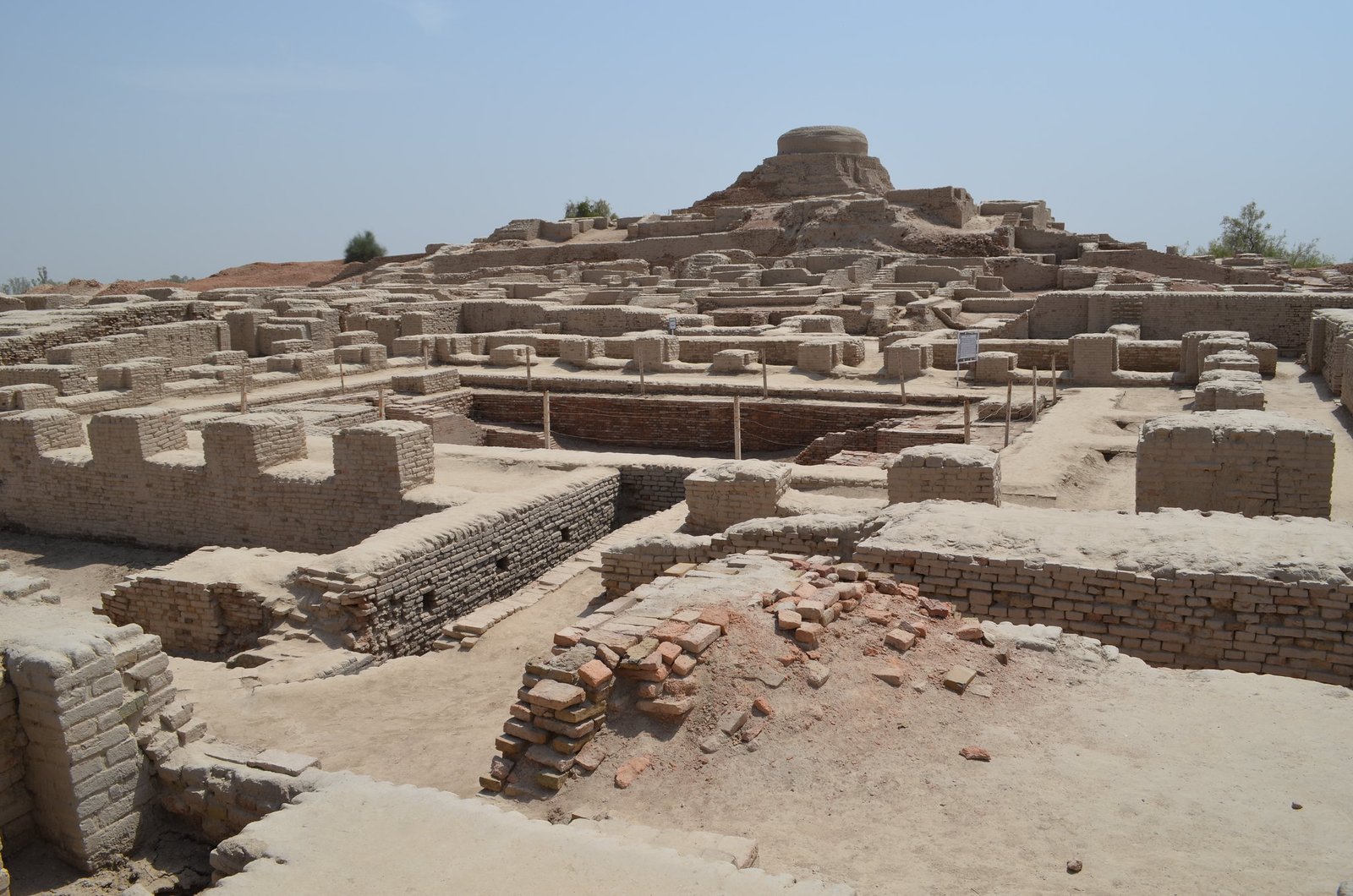Table of Contents
Indus civilization, also known as the Indus Valley Civilization or Harappan civilization, is
the earliest known urban culture of the Indian subcontinent. It is also called the Saraswati
civilization or Ghaggar Hakra civilization.
Indus Valley Civilization
different views regarding the name of the civilization
- This civilization was dubbed the Indus Valley civilization by John Marshall.
- The name was contested because of its wide geographic scope and in accordance with archaeological convention, which resulted in the term “Harappan civilization” being adopted since Harappa was the designated site.
- It was dubbed the Saraswati civilization or Ghaghar Hakkara civilization by Indian scholars in 1970.
- In 1990, researchers began to postulate that the Harappan civilization was the result of a protracted and intricate cultural development that involved at least three phases:
- Phase I: Early Harappan–Protourban.
- Urban phase of mature Harappans
- Post-urban phase of late Harappan history. Cities experienced a downturn.
- A researcher by the name of Jim Shaffer coined the phrase “Indus Valley tradition” in 1992.
different views regarding the date of IVC
- It flourished around Mesopotamian civilization, roughly between 3250 and 2750 BC, according to John Marshal.
- The revision of the Mesopotamian chronology resulted in the revision of the Harappan civilization’s date from 2350 to 1900 BC.
- When radiocarbon dating was introduced after the 1950s, some researchers provided additional information.
For example, the historian D.P. Agarwal proposed the period between 2300 and 2000 BC. According to some academics, our dates are different and we live in different zones. One date cannot be used in all zones. As a result, a broad chronology emerged through the division of Harappan civilization into three distinct phases.
- Eerily Phase : 3500 to 2600 BC
- Mature Phase : 2600–1900 BC
- Late Period : circa 1900–1300 BC
Origin of Indus Valley civilization
Foreign origin theory Or diffusionist explanation
- Mackay proposed the “migration theory,” which was backed by Gordon and Krammer, which holds that this civilization originated from a migration of people from Sumer Mesopotamia. We refer to this as migration theory.
- As per Mortimer Wheeler, the ideas that left Mesopotamia migrated. The Indus Valley civilization resulted from that.
- Lamberg Karlovasky suggested that interaction with Turkamenia and south Afghanistan played an important part in Harappan urbanism.
- The Harappan civilization benefited greatly from the trade connections with Mesopotamia, according to Shreen Ratnagar. They also proposed that Mesopotamian civilization was the progenitor of the Indus Valley. But over time, this viewpoint was abandoned because of the glaring distinctions with Mesopotamian civilization. Historians proposed that the Mesopotamians employed a vast canal system, had distinct writing systems, and different settlement designs.
Indigenous origin theory
The idea of indigenous origins based on:
- The work of M.G. Majumdar on Amri
- The Kotdigi work of F.A. Khan
- A. Good work on the Rajasthani Sothi.
- Mughals is employed in Baluchistan.
- According to F.R. Allchins and Bridget Allchins, the Indus Valley’s pre-Harappan culture was the ancestor of Harappan civilization. They also backed up the claim that the foundation of mature Harappan culture was laid by early Harappan culture.
According to F.R. Allchins, and Bridget Allchins Harappan civilization derived from the
pre-Harappan culture of the Indus Valley itself. They also supported the argument that
early-harappan culture provided the base for mature-harappan culture.
Conclusion
Evidence currently available indicates that the Harappan ancestors lived in villages and small towns on the Indian subcontinent. They were initially nomadic, but as time went on, they turned to agriculture and trade; as a result, the Harappan civilization is the result of a protracted period of agricultural and semi-nomadic community revolution. Before the Harappan civilization, there were numerous regional customs; these eventually came together to form the Indus Valley civilization.
Early Indus Valley Civilization / Harappan Cultures
According to historians we have mainly four examples of Early Harappan Cultures
- Kot Diji culture – 111 sites have been identified.
- Damb Sadat culture – 37 sites have been identified.
- Amri nal culture – 164 sites have been identified.
- Sothi Siswal cultures – 165 sites have been identified.
Below cultures showcased proto-urban features of Early Indus Valley Civilization
- Kot Diji culture: Known for its unique brand of well-fired red and buff ware pottery. The ceramics featured a variety of motifs, including fish scales, horn deities, and pipal leaves. The most common type of pottery connected to Early Harappan cultures is called kotdiji pottery. Sarai Khola, Tarkai Qila, Lewan, and Rahman Dheri are a few well-known locations associated with Kotdiji culture.
- Damb Sadat cultures: These civilizations originated in the region of central Baluchistan. The three most significant Damb Sadat cultural sites are Nausharo, Mehargarh, and Mundigak.
- Amrinal culture: Notable locations that embody Amrinal culture are Padri, Kuntasi, and Dhaulavira, all of which are located in Gujarat.
- Sothi Siswal cultures: Rajasthan and Haryana are the places where this culture originated. Several significant locations include Rajasthan -> Kalibangan and Balu.
Harappan Civilization
The extent of Harappan Civilization

- This civilization extended beyond the boundaries of the Indus Valley. It included Sindh, Punjab, Cholistan, Baluchistan, and Afghanistan. It also covered Maharastra, Gujrat, Rajasthan, the Gangetic plane, and Gujrat. In Baluchistan, Sutkagendor stands in for the civilization’s western boundary.
- The northern boundary of the Harappan Civilization remains a subject of debate among historians. Several academics have suggested that this ancient civilization might extend northward to Manda (Jammu), Ropar (Punjab), and Shortughai (Afghanistan).
- Daimabad, located in Maharashtra, symbolizes the southern boundary of the Harappan civilization.
- Alamgirpur and Bargaon represent this civilization’s eastern boundary.
- This civilization inhabited an area of about twenty billion square kilometers. This civilization was more extensive than Egypt’s and Mesopotamia’s modern civilizations combined.
- The majority of settlements were built in semi-arid, low-rainfall areas with saline ground water. According to D.P. Agarwal and Sood’s research, the strong Ghaggar and Saraswati rivers were once present. Even though there are still signs of the canal, the river most likely dried up, creating a potentially saline and semiarid environment.
- Wheeler and Stuart Piggott thought that the Harappan civilization demonstrated unity of conception and urban character.
Following are the characteristics of Urban area given by Gordon Child
- Compared to villages, the earliest cities in history were bigger and had denser populations.
- The city’s population consisted of full-time artisans, merchants, transporters, officials, and priests in addition to a small number of farmers and herdsmen.
The excess food that farmers produced was used to support these groups. - As a tax or tribute to the ruling class, farmers were required to turn over their excess produce.
- Monumental public buildings were the distinguishing feature of cities and demonstrated how the elite controlled the majority of the surplus produce and wealth created in society.
- The ruling class and the general populace engaged in a trade-off. Farmers produced surplus, which rulers lived off of in exchange for peace, security, organization, and forethought.
- The development of writing and numeric notation systems aided in meeting administrative needs.
- The development of writing resulted in the creation of a calendar and precise but useful sciences like astronomy, geometry, and arithmetic.
- Sophisticated and conceptualized artistic expression methods emerged.
- Cities suggested a substantial volume of trade over long distances.
- They also suggested that a territory’s residents would be grouped into states rather than families. Expert craftspeople were able to live a settled rather than nomadic life because the state gave them materials and security.
- The majority of IVC sites had a rural setting. There were fewer than fifty urban locations. As such, there is uncertainty about IVC’s urban character.
- Wheeler and Stuart Piggott assert that the ideas underlying the Indus Valley civilization were united. Nonetheless, contemporary historians now hold that residents of various places encounter a variety of difficulties that reflect regional diversity. Various locations, such as Dholavira, Lothal, etc., are representative of character diversity. Diversity is more strongly supported than uniformity.
General features of Indus Valley Civilization
The town planning of this Harappan civilization was well-known. Large cities with comparable designs include Mohandaro and Harappan, though there are also differences. Harappan cities are typically separated into two sections: the lower town and the citadel.
Citadel (Western) : Located on the western side, this raised area was usually fortified, and public structures were built inside.
Lower town : It was located to the east. In most cases, it wasn’t defended. It was made up of single-family homes or modest structures. The layout of the streets and roads was grid-based. They were at a straight angle intersection. Cross streets and the main street, which runs from north to south, met at a right angle.
Variation : We discovered indications of distinct settlement patterns at different locations. There were three different sizes of settlements: big, medium, and small.
A sizable settlement with more than 80 houses. large settlement in Haryana’s Rakhi Gaddi.
sizable community in Gujrat. Kalibangan is a site settlement that is moderate. Surkodta, Allahdino is an extremely small site settlement.
In Chanhudaro, Citadel was nonexistent. The regions of Lothal and Surkodta were not divided. The city of Dhaulavira was divided into three sections: Citadel, Middle Town, and Lower Town.
The aforementioned observations point to differences in Harappan city town planning. Historians have found that, in contrast to homogeneity, Harappan town planning had a greater diversity of elements.
Pre & Mains : Buy History NCERT 11th class by R.S.Sharma for UPSC
History Optional : Buy A History of Ancient And Early Medieval India : From the Stone Age to the 12th Century By Upinder Singh
Featured image credit :- World History Encyclopedia
Inline image credit :- World History Encyclopedia
